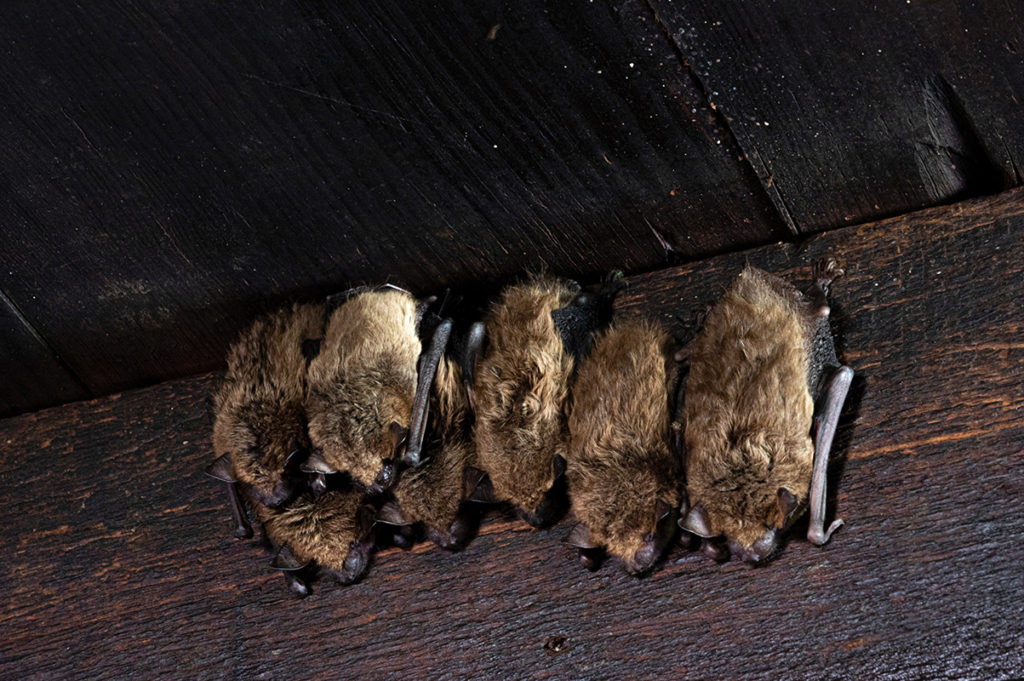If you live near a cave or sheltered area, then you have probably seen bats during the twilight hours of the summer. Despite their reputation in literature, bats are quite welcome as they feast on many insects every night. But the question does arise of where do bats go in the winter? After all, their main prey is hibernating or otherwise have left the area. So, what happens to the bats?
Hibernation
For the most part, the answer to the question of where do bats go in the winter is that they do not go anywhere. As with some other mammals, most notably bears, bats will hibernate in their homes which are usually caves or sheltered areas that provide cover and a place for them to roost. However, not all of them. Read on!
Bats enter into hibernation, also known as torpor, from around October to April/May. Bats going into hibernation is more to do with food availability rather than the fact it is too cold. As they feed on insects, there is very little for them to eat during the winter.
These warm-blooded animals slow down their metabolism and rely only on their fat reserves. Bats can slow down their heart beat from around 250 beats per minute to 25 beats per minute. They can also reduce their body temperature from 34 Celsius Degrees (93 F) to approximately 7 Celsius Degrees (45 F).
Unlike bears who hibernate for months at a time, bats wake up from hibernation/torpor once or twice a month before they go back to deep sleep. They do so to regulate their metabolism, defecate, urinate or mate. Occasionally the temperature can rise dramatically prompting bats to wake up.
They cannot wake up too often as this uses up too much of their energy reserves. They will not survive the winter otherwise. It is believed that bats use 80% of their energy reserves repeatedly waking up during the winter.

There are some species of bats such as the Little Brown Bat that may hibernate for the entire winter. The hibernation will depend in large part on how long the temperatures remain below freezing. The less severe the temperatures, the less the bats will stay in hibernation.
Of course, for some areas that are near the equator, the winter months are simply not that cold or rarely see any freezing conditions. In such cases, the bats do not hibernate as their food supply is still quite active.
Also Read: Where Do Hummingbirds Go in the Winter?
Migration
The answer to the question of where do bats go in the winter, at least for most of them, is nowhere, they stay in their homes. However, there are some species of bats that do migrate just like many birds do in the autumn. Some bats will fly towards the equator seeking warmer weather conditions. They will find homes in caves along with other bats or they will find other places that provide the shelter they need.
Caves are the most obvious homes for bats as they provide the shelter they require. Plus, their claws can dig into the cracks and crevices in the ceiling, so that they can secure their resting spot. Hanging upside down, the bats sleep, groom themselves, and engage in other activities while remaining safe in the cave.
Other places bats call home includes mines, rock crevices, cellars, holes in trees and structures that allow them to roost. But whether bats hibernate or migrate, they are creatures of habit. And once they find a home they like, they will return to it time and time again until they are removed. This includes your attic.
Calling Your Attic Home
Unfortunately, bats will find the best place possible to hibernate for the winter. And that means your attic is a prime location. The attic provides shelter and heat for them to roost. And while a bat is generally no harm to anyone in the household, their feces can be quite harmful. Bat feces or guano, as it is commonly known, makes for an excellent fertilizer. But it also contains many harmful germs and bacteria that present a threat to the health of those living inside.
Plus, the build-up of guano also presents a threat to the home itself. The combination of organic materials and moisture may allow for the growth of mold if enough heat is present inside the attic. This can lead to an expensive clean up if the bats stay for any appreciable amount of time.
And then there is the smell which may be the most foul of all. You will not have to ask where do bats go in the winter when you get one whiff of the guano they produce.

Cleaning Up Your Attic
If you discover bats in your attic, the best advice is to call a professional pest control expert. They will safely remove the bats from your attic. Because bats tend to hibernate during the winter months, their removal is usually free of incident.
If there is no professional nearby, you can remove the bats yourself. Wear gloves, eye protection, and a jacket with long sleeves. When the bats are perched and it is cold, they can be handled. Put the bats into a container with holes so that they can breathe. When the temperatures are above freezing, you can release the bats and they will find another home.
Once removed, you can then clean up the mess they have created. You will want to wear a mask, gloves, and eye protection as you scoop up the guano and place it into a sealable container. You can then dispose of the guano or use it as fertilizer for your lawn during the spring months.
When the guano is removed, use a disinfectant to kill any remaining germs and bacteria on the surface. This will also destroy any mold that might be present as well. Once fully cleaned, inspect the attic to find any openings, so that they can be sealed properly preventing the bats return.
Also Read: Where Do Puffins Live?
Creating a Bat Home
After sealing up your attic, you can provide the bats a home by either purchasing or creating a box that can be placed high off the ground. The box should be made of wood and provide a perch inside for them to roost.
The bats can then feast on the insects around your home at night while sleeping during the day. The only caveat is that you need a way to collect the guano as it will drop to the ground. You can use the guano as fertilizer for your garden or lawn.
Understanding where do bats go in the winter will help you prepare if they decide to make your attic a home. Be sure to check your attic every so often to ensure that all openings are sealed. The last thing you want is a group of bats who call your attic home during the winter or at any time of the year.

